|
Reminder:
An IDES representative will conduct small group meetings every 30 minutes in the Wilson Hall Atrium Dining Room (SW corner) each Friday from 11 a.m. to 1:30 p.m. from tomorrow through the end of March.
New furlough information, including an up-to-date Q&A section, appears on the furlough Web pages daily.
|
|
Thursday, March 6
12 p.m.
Grid School Brown Bag Seminar - Curia II
Speaker: K. Chadwick, Fermilab
Title: FermiGrid 101 - FermiGrid Introduction and Overview
THERE WILL BE NO PHYSICS AND DETECTOR SEMINAR THIS WEEK
2:30-4:30 p.m.
Joint Theory-CMS Seminar - One West
Speaker: M. Narain, Brown University
Title: Mass Determination Using Events with Charged Leptons and Missing Transverse Momentum from the Tevatron to the LHC
3:30 p.m. (part of the Joint Theory seminar)
Speaker: J. Gunion, University of California, Davis
Title: Accurate Mass Determinations in Decay Chains with Missing Energy
3:30 p.m.
DIRECTOR'S COFFEE BREAK - 2nd Flr X-Over
THERE WILL BE NO ACCELERATOR PHYSICS AND TECHNOLOGY SEMINAR TODAY
Friday, March 7
3:30 p.m.
DIRECTOR'S COFFEE BREAK - 2nd Flr X-Over
4:00 p.m.
Joint Experimental-Theoretical Physics Seminar - One West
Speaker: S. Nelson, Stanford Linear Accelerator Center
Title: B Decays with t Leptons in the Final State at BaBar
8:00 p.m.
Fermilab International Film Society - Auditorium
Tickets: Adults $5
Title: Tito i ja (Tito and Me)
Sunday, March 9
2:30 p.m.
Gallery Chamber Series - 2nd Floor Art Gallery
Tickets: $15
Linda Marianiello, Baroque and Traditional Flute with David Schrader, Harpsichord
Click here for NALCAL,
a weekly calendar with links to additional information.
|
Thursday, March 6
- Minnesota wild rice w/chicken
- Tuna melt on nine grain
- BBQ ribs
- Chicken casserole
- Vegetarian salad wrap
- Assorted pizza slices
- Mandarin chicken
Wilson Hall Cafe menu |
|
Thursday, March 6
Dinner
- Mushroom duxelle
- Sautéed flounder w/shrimp
- Lacey potato pancakes w/chives
- Steamed green beans
- Marzipan soufflé w/bittersweet chocolate sauce
Wednesday, March 12
Dinner
- Moussaka
- Greek salad
- Baklava
Chez Leon menu
Call x4598 to make your reservation. |
|
|
Fermilab houses connect
past and future
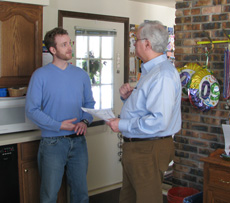
Andrew McCullough talks to current resident and Fermilab physicist Luciano Ristori about the home, where McCullough's mother lived as a child.
As a child, Andrew McCullough's mom used to drive him through Fermilab and point out a white clapboard house that she grew up in.
Last week, a grown man with two boys of his own, McCullough crossed the home's threshold for the first time.
Italian physicist Luciano Ristori and his wife, Mara, who have lived in the home for five years, welcomed McCullough with a tour and homemade pizza.
The Ristoris were eager to hear about the history of the decades-old structure they consider as much a home as their house in Italy. McCullough wanted to share a bit of his heritage with his current family and learn about how his mother's home plays a role in Fermilab's search for an understanding of the universe.
While McCullough's mother, Mary, was not happy when the laboratory bought out Sunbonnet Farm, he said that growing up nearby he has learned to appreciate the laboratory for its science and environmental preservation.
"It is wonderful to have Fermilab here in Batavia, so there are no hard feelings," he said. McCullough's mother and her brother used to tell Andrew stories of hunting and playing in the woods. He hopes to walk his twin sons on the nature trails through those woods.
The family also talked of attending square dances on what is now Site 38.
"These square dances were a big draw. People came from Wisconsin and Indiana," McCullough said.
Roughly two dozen farm homes were relocated in 1977 from throughout the site to the Village. Today, they house physicists, like Ristori, drawn to Fermilab from across the globe.
McCullough surveyed the home's old wood charm and brick fireplace, asking about Ristori's job as a physicist, while Ristori peppered him with questions about the life before the laboratory.
Ristori, who works on CDF, moved from Naperville to the village as soon as the house became available to be close to colleagues and nature.
"It's nicer," he said.
-- Tona Kunz
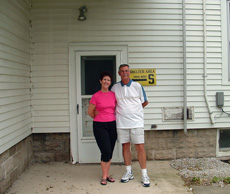
On a similar quest to see family history, John Komes and his wife, Terry, visited the home of John's uncle Ed Kames during a visit from California last year. The former farm of his similarly-named uncle is now Site 51. Its barns house maintenance instead of farm equipment, but Komes could still recall summer days spent playing on the farm as a child.
|
Winter hunt
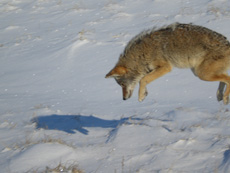
DZero's Robert Barger sent in this series of photos of a coyote hunting for food. The photo was taken outside Fermilab's Main Ring, just north of CZero. The coyote was unsuccessful and went away hungry.
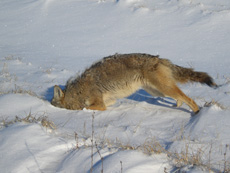
|
Is dark matter made of axions?
From Physorg.com,
Feb. 26, 2008
One of the mysteries of our universe is that of dark energy and matter. Scientists all over the world are attempting to discover what particles make up dark energy and matter. "Axions are one of the particles considered for dark matter," William Wester tells PhysOrg.com. "We were hoping to get a signal proving that they exist with this experiment."
Wester, a scientist at the Fermi National Accelerator Laboratory in Batavia, Illinois, worked closely with Aaron Chou, now at New York University, and a group of scientists from Fermilab and the University of Michigan in Ann Arbor, to design an experiment to test the existence of axion-like particles within a certain range. Their results can be found in Physical Review Letters: "Search for Axionlike Particles Using a Variable-Baseline Photon-Regeneration Technique."
Axions are hypothetical particles that have a small mass in the milli-electronvolt (eV) range, making them 500 million times lighter than an electron. Additionally, an axion should have no spin.
"Normally," Chou points out, "we can only detect these kinds of particles with telescopes, looking out into space. And then it is only an indirect detection." The idea was to create conditions allowing them to detect particles in the milli-eV range during a lab experiment.
"For particles that interact strongly enough for us to detect, there are constraints on where they could exist or not," Chou continues. "For the specific region of our experiment, no one would have thought to look into it without the PVLAS experiment."
Read more
|
|
|
Finding needles in a
haystack of collisions
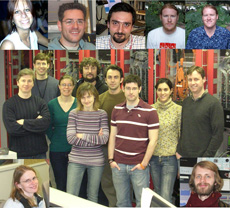
Top: Anadi Canepa, U. Penn; Giorgio Cortiana, INFN Padova; Massimo Casarsa, Fermilab; Charles Cox and David Cox, UC Davis.
Main photo from left to right: Andrew Ivanov, Aron Soha and Alison Lister, UC Davis; Laura Sartori, INFN Pisa; Vadim Rusu, University of Chicago; Rob Forrest, UC Davis; Miguel Vidal, CIEMAT; Olga Norniella, University of Illinois; and Gene Flanagan, Purdue University.
Bottom: Heather Gerberich, University of Illinois; and Nils Krumnack, Baylor University.
Not pictured: Dan Krop, Henry Frisch, Rich Northorp, Harold Sanders, Fukun Tang and Lin Zhou, University of Chicago; Robin Erbacher, UC Davis; Ted Liu and Scott Holm, Fermilab; Ryan Mokos, Kevin Pitts and Greg Veramendi, University of Illinois; Paola Giannetti, Virginia Greco, Marco Piendibene and Lucas Rogondino, INFN Pisa.
An average of 2.5 million collisions occur per second at each interaction point in the Tevatron. With the machine's current performance, CDF receives two potential Higgs events per day, needles in a haystack of particle events. To get more potential needles, the Tevatron smashes more particles.
To handle this increase, CDF physicists upgraded the trigger system, the smart system that makes sure these precious needles don't get lost. A strong and dedicated team of young CDF scientists recently completed three upgrades to the second of three trigger levels. The improvements reduce some of the system's bottlenecks and consist of two upgrades to the tracking system and one to the calorimeter system. The upgraded track triggering, which followed an upgrade to the Level 1 component, uses more of the detector layers in the track reconstruction; in particular, it helps to reduce the number of bad tracks that CDF collects by making 3D track reconstruction available at Level 2 for the first time.
The second tracking upgrade installed an electronics board that provides the tracking information to all other Level 2 components more quickly. The calorimeter upgrade replaces hard-coded logic in custom electronics. Energy measurements from the full calorimeter are now sent to a computer that can reconstruct particle signatures with software algorithms similar to those used in physics analyses.
The new Level 2 triggering system collects less unwanted hay at high luminosity, thus allowing the trigger system to collect more of the interesting needle events. All three upgraded systems were recently commissioned and CDF is now taking data with the improved Level 2 trigger system. The physicists at CDF hope that the new system will make it easier to find that elusive Higgs in the haystack of collisions.
Result of the Week Archive
|
|
Have a safe day!
IDES representative on site Friday
An IDES representative will be on site in the Wilson Hall Atrium Dining Room (SW corner) Fridays through the end of March. Small group meetings will occur every 30 minutes, beginning at 11 a.m. and ending with a final meeting at 1 p.m. If you are beginning your furlough week, please fill out a benefit application on-site. You may also apply for benefits online or at your local IDES office the week you are on furlough. Please contact Heather Sidman x3326 or Jeannelle Smith x4367 with questions.
2008 CTEQ-MCnet School August 8-16
Applications are now accepted for the 2008 CTEQ-MCnet Summer School on QCD Phenomenology and Monte Carlo Event Generators from August 8-16 in Debrecen, Hungary. The CTEQ-MCnet School program will include lectures on QCD theory, phenomenology and analysis as well as a practical approach to event generator physics and techniques with hands-on sessions using the techniques in real analyses. The application deadline is April 30, 2008. Enrollment will be limited to 80 participants. Application procedures and additional information are available here.
Computing Techniques Seminar
On March 12 at 3 p.m. in Curia II, Fermilab will offer C++: New and Improved!, a Computing Techniques Seminar that will present an overview of changes forthcoming in the next C++ standard.
Walter Brown, who participates on Fermilab's behalf in the international C++ standardization effort, is the presenter. He is a member of the Computing Division's LSC department.
DreamWeaver CS3: Advanced
An advanced course on DreamWeaver CS3 is offered. This course is targeted to Web site developers, Web site designers, marketing managers, Web graphic artists and Web site administrators. Learn more and enroll
Excel 2003 Intermediate
An intermediate class on Excel 2003 is offered. Learn how to create templates, sort and filter data, import and export data,
analyze data and work with Excel on the Web. Learn more and enroll
U of C Tuition Remission program deadline March 10
The deadline for applying for the tuition remission program at The
University of Chicago for the Spring 2008 quarter is March 10.
See the Web site for more information or contact Karen Karlix, x4365 with questions.
International Folk Dance March 6
International Folk Dancing will meet Thursday, March 6, at Kuhn Barn on the Fermilab site. Dancing begins at 7:30 p.m. with teaching and children's dances earlier in the evening and request dancing later on. Newcomers are welcome and you do not need to come with a partner. Get more information at 630-584-0825 or 630-840-8194 or folkdance@fnal.gov.
Additional Activities |
|